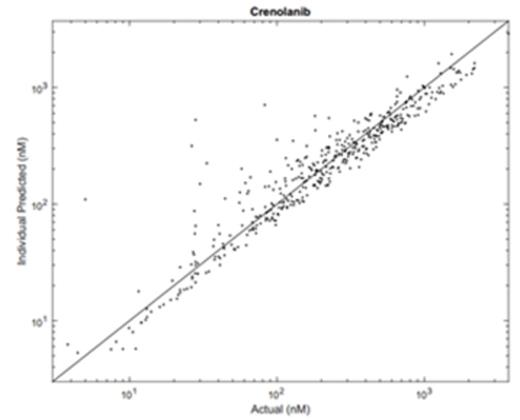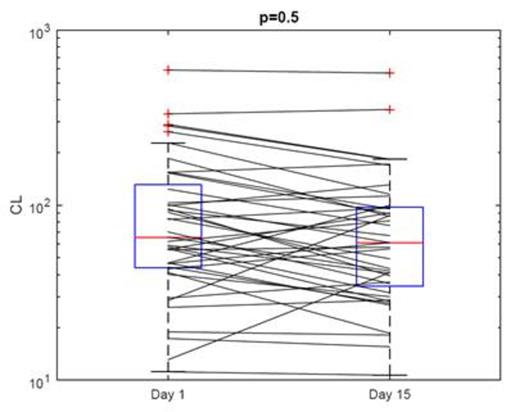Abstract
Background:
Crenolanib besylate is a selective and potent type I tyrosine kinase inhibitor (TKI) of wild-type and mutant FMS-like tyrosine kinase 3 (FLT3). Crenolanib is being studied in patients with relapsed/refractory FLT3+ AML with FLT3-ITD and/or FLT3-D835 mutations. This abstract summarizes the population pharmacokinetics (PK) of crenolanib in patients with relapsed or refractory FLT3+ AML.
Methods:
Serum blood samples were collected on Day-1 at pre-dose and at 30 min, 60 min, 120 min, 4 h, 8 h and 24 h after single dose of crenolanib and steady state levels were obtained on Day-15. All crenolanib serum concentrations were measured by a validated LC-MS/MS. The crenolanib population pharmacokinetics and individual post-hoc estimates were determined by non-linear mixed effects modeling. The inter-individual and inter-occasion (day 1 vs day 15 studies) variability of the parameters was assumed to be log normally distributed. The area under the concentration-time curve from 0 to 24 hours (AUC; nmol hr/L), maximum concentration (Cmax; nM), and time to maximum concentration (Tmax; hr) were determined from the concentration-time profile simulated using each individual's post-hoc estimated pharmacokinetic parameters.
Results:
Crenolanib was found to be rapidly absorbed with a Tmax of 2-3 hours after administration.
Crenolanib serum concentration data in cancer patients were best described by a one-compartment PK model with first-order oral absorption. The model was parameterized in terms of ka (1/hr), the first-order absorption; Tlag (hr), lag time; CL (L/hr), apparent oral clearance; and V (L), apparent volume.
The predictive accuracy of the model used to forecast these values showed that most of the predicted values are close to the actual values with approximately equal distribution of points on either side of the diagonal line. Hence, the model can be said to be unbiased and fairly accurate.
In an attempt to maximize the trough levels and lower Cmax of crenolanib to continually inhibit FLT3, patients were administered crenolanib on a TID schedule. Comparable AUC was reached when crenolanib was administered three times daily as opposed to once daily. By day 4 of TID dosing, patients can be expected to reach an approximate steady state. During the fourth day of dosing, the predicted median Cmax was 478 nM (10th percentile of 169 nM and 90th percentile of 1478 nM) and the predicted median trough value was 290 nM (10th percentile of 89 nM and 90th percentile of 943). 100 mg TID dosing should maintain constant inhibition of FLT3, potentially increasing their rate of response.
Day 1 and day 15 pharmacokinetics suggested that no change in crenolanib clearance occurs over time.
Conclusions:
Crenolanib is rapidly absorbed with first order pharmacokinetics. Administering crenolanib on a TID schedule allows for a total dose of 300 mg per day of crenolanib, while still maintaining adequate pharmacokinetic properties to lower Cmax and achieve higher trough levels. Pharmacokinetic profiling of crenolanib over a longer period of time showed that crenolanib does not accumulate with extended use.
Macaraeg:Arog Pharmaceuticals: Employment. Makinde:Arog Pharmaceuticals: Employment. Vali:Arog Pharmaceuticals: Employment. Ramachandran:AROG Pharmaceuticals: Employment. Cortes:BMS: Consultancy, Research Funding; Novartis: Consultancy, Research Funding; Pfizer: Consultancy, Research Funding; BerGenBio AS: Research Funding; Teva: Research Funding; Ariad: Consultancy, Research Funding; Astellas: Consultancy, Research Funding; Ambit: Consultancy, Research Funding; Arog: Research Funding; Celator: Research Funding; Jenssen: Consultancy.
Author notes
Asterisk with author names denotes non-ASH members.




This feature is available to Subscribers Only
Sign In or Create an Account Close Modal